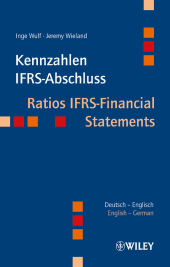 Neuerscheinungen 2013Stand: 2020-01-07 |
Schnellsuche
ISBN/Stichwort/Autor
|
Herderstraße 10
10625 Berlin
Tel.: 030 315 714 16
Fax 030 315 714 14
info@buchspektrum.de |

Jeremy Wieland, Inge Wulf
(Beteiligte)
Kennzahlen IFRS-Abschluss / Ratios IFRS-Financial Statements
Deutsch-Englisch /English-German
1. Aufl. 2013. 220 S. 10 SW-Abb. 165 mm
Verlag/Jahr: WILEY-VCH 2013
ISBN: 3-527-50642-X (352750642X)
Neue ISBN: 978-3-527-50642-2 (9783527506422)
Preis und Lieferzeit: Bitte klicken
IFRS-Kennzahlen im praktischen Pocketformat in Deutsch und Englisch.
Das Business Fachbuch "Kennzahlen IFRS-Abschluss" beinhaltet, jeweils in Deutsch und Englisch, zu jeder IFRS-Kennzahl:
- die Formel
- Erläuterung der Aussagekraft der Kennzahl
- Vor- und Nachteile der Anwendung der Kennzahl
- Rechenbeispiele
- Zusammenhang zu anderen Kennzahlen
- Bedeutungsvergleich HGB/IFRSInklusive
Stichwortverzeichnis mit allen IFRS-Kennzahlen in Deutsch und Englisch.
Vorwort 18
1 Beispiel-Unternehmen 21
1.1 Gesamtergebnisrechnung 22
1.2 Bilanz 26
1.3 Kapitalflussrechnung 30
1.4 Weitere Angaben 34
2 Kennzahlen zur Verm‡genslage 39
2.1 Anlagenintensitt 40
2.2 Sachanlagenintensitt 42
2.3 Immaterialanlagenintensitt 44
2.4 Verm‡gensstruktur 46
2.5 Konzernverflechtung 48
2.6 Umlaufintensitt 50
2.7 Vorrats- und Forderungsintensitt 52
2.8 Investitionsquote (Sachanlageverm‡gen (SAV)) 54
2.9 Investitionsquote (Finanzanlageverm‡gen (FAV)) 56
2.10 Wachstumsquote (SAV) 58
2.11 Investitionsdeckung (SAV) 60
2.12 Anlagenabnutzungsgrad (SAV) 62
2.13 Abschreibungsquote (SAV) 64
2.14 Investiertes Kapital 66
2.15 Umschlagshufigkeit des Gesamtverm‡gens 68
2.16 Umschlagshufigkeit des Sachanlageverm‡gens 70
2.17 Umschlagshufigkeit des kurzfristigen Verm‡gens 72
2.18 Bindungsdauer des Vorratsverm‡gens 74
2.19 Beschftigung (= Kapazittsauslastung) 76
2.20 Investitionen in % des Umsatzes 78
2.21 Sachanlagen zu Umsatz 80
2.22 Stille Reserven/stille Lasten 82
Preface 19
1 Company example 21
1.1 Comprehensive income statement 23
1.2 Balance sheet 27
1.3 Cash flow statement 31
1.4 Further disclosures 35
2 Asset Ratios 39
2.1 Fixed asset intensity 41
2.2 Property, plant and equipment (PPE) intensity 43
2.3 Intangible fixed asset intensity 45
2.4 Asset structure 47
2.5 Concentration of combines 49
2.6 Current asset intensity 51
2.7 Inventory and receivables intensity 53
2.8 Investment ratio (property, plant and equipment (PPE)) 55
2.9 Investment ratio (financial assets (FA)) 57
2.10 Growth rate (PPE) 59
2.11 Investment coverage (PPE) 61
2.12 Degree of asset depreciation (PPE) 63
2.13 Depreciation rate (PPE) 65
2.14 Invested capital 67
2.15 Turnover ratio of total assets 69
2.16 Turnover ratio of property, plant and equipment (PPE) 71
2.17 Turnover ratio of current assets 73
2.18 Commitment period of inventories 75
2.19 Capacity utilization 77
2.20 Investment as percentage of revenue 79
2.21 Property, plant and equipment (PPE) to revenue 81
2.22 Hidden reserves/hidden liabilities 83
2.23 Kundenziel 84
2.24 Debitorenumschlag 86
3 Kennzahlen zur Finanzlage 89
3.1 Bilanzanalytisches Eigenkapital 90
3.2 Bereinigtes Eigenkapital 92
3.3 Eigenkapitalquote 94
3.4 Rcklagenquote 96
3.5 Selbstfinanzierungsgrad 98
3.6 Langfristkapitalanteil 100
3.7 Fremdkapitalquote 102
3.8 Fremdkapitalquote (kurzfristig) 104
3.9 Fremdkapitalstruktur 106
3.10 Rckstellungsquote 108
3.11 Statischer Verschuldungsgrad 110
3.12 Deckungsgrad A 112
3.13 Deckungsgrad B 114
3.14 Goldene Finanzierungsregel 116
3.15 Effektivverschuldung (absolut) 118
3.16 Effektivverschuldung (relativ) 120
3.17 Tilgungsfhigkeit 122
3.18 Kreditorenlaufzeit 124
3.19 Kreditorenumschlagshufigkeit 126
3.20 Geldumschlagsdauer 128
3.21 Liquiditt 1. Grades 130
3.22 Liquiditt 2. Grades 132
3.23 Liquiditt 3. Grades 134
3.24 Working Capital (absolut) 136
3.25 Working Capital (relativ) 138
3.26 Kapitalbindungsdauer 140
3.27 Cashflow aus betrieblicher Ttigkeit - Ermittlungsmethoden 142
2.23 Customer payment target 85
2.24 Accounts receivable turnover 87
3 Financial Standing Ratios 89
3.1 Balance sheet analytical equity 91
3.2 Adjusted equity 93
3.3 Equity ratio 95
3.4 Reserves ratio 97
3.5 Self-financing rate 99
3.6 Long-term capital share 101
3.7 Debt ratio 103
3.8 Debt ratio (short-term) 105
3.9 Debt structure 107
3.10 Provisions rate 109
3.11 Static debt-equity ratio 111
3.12 Cover ratio A 113
3.13 Cover ratio B 115
3.14 Golden rule of financing 117
3.15 Effective debt (absolute) 119
3.16 Effective debt (relative) 121
3.17 Redemption capability 123
3.18 Days payable outstanding (DPO) 125
3.19 Payables turnover ratio 127
3.20 Cash conversion cycle (CCC) 129


